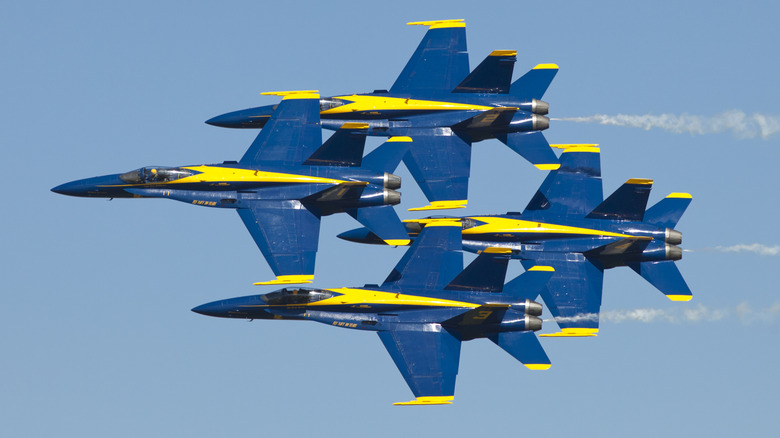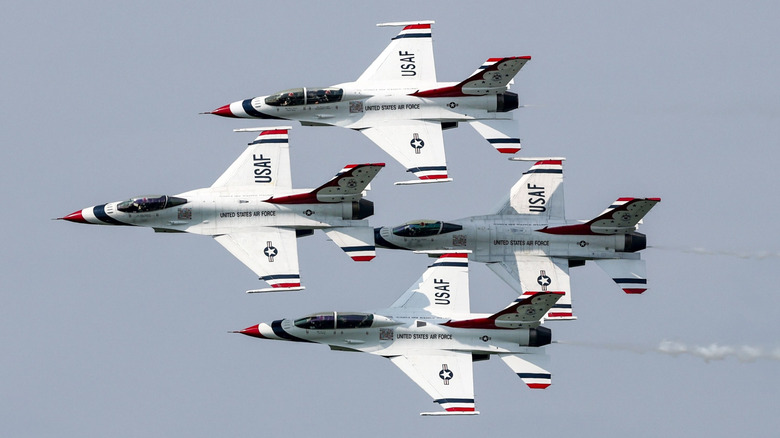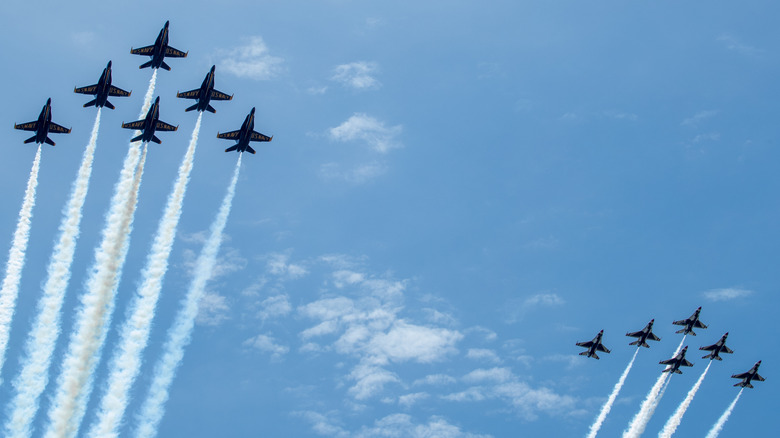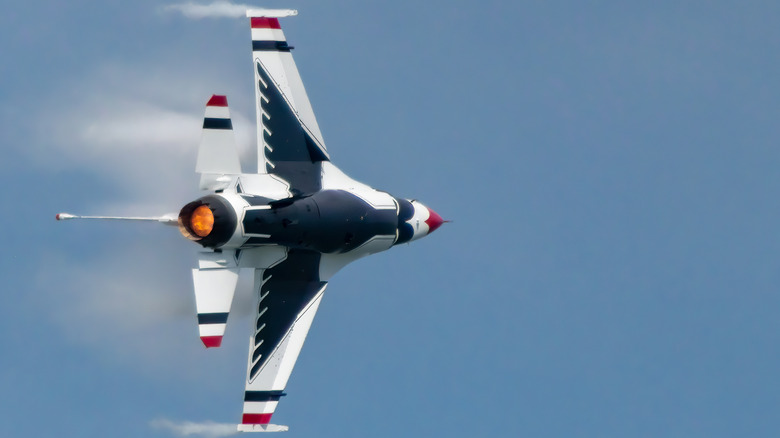Thunderbirds Vs. Blue Angels: What's The Difference Between These Military Flying Teams?
The US loves its airshows. Each year, there are between 325 and 350 shows across the US and Canada, with an estimated 10 to 12 million people attending these. One of the major attractions of many of these shows is military display teams like the Blue Angels and Thunderbirds. Both teams are world-renowned for their thrilling aerial displays, extraordinary skill, and razor-sharp precision. At first glance, they may seem similar — both exist primarily to demonstrate the capabilities of their respective branches of the military and to inspire and recruit future aviators — but a closer look reveals clear distinctions.
The primary difference is the military branch the teams hail from. The Thunderbirds are the official demonstration squadron for the United States Air Force (USAF), and the Blue Angels are the US Navy's equivalent. Both teams have rich histories stretching back decades. The Blue Angels are the oldest of the two teams, having been formed just after World War 2 in 1946. The Thunderbirds team was formed a few years later in 1953. Since then, both teams have been thrilling crowds in the US and further afield.
Thunderbirds and Blue Angels planes, explained
While the primary difference between the two is the branch of the military they're associated with, it's far from being the only difference. The biggest point of distinction might be the type of planes they fly. The Blue Angels fly the Boeing F/A-18 Super Hornet, while the Thunderbirds fly Lockheed Martin F-16 Fighting Falcons. This is an important distinction, as it has a direct effect on the type of show that the teams put on. Because the F-16 is faster due to a higher thrust-to-weight ratio, the Thunderbirds put on faster shows. However, the Blue Angels team tends to fly in tighter formations.
In terms of plane numbers, both teams are similar. The Blue Angels squadron flies 11 aircraft: two F/A-18F two-seat jets, and nine of the display aircraft — the single-seat F/A-18E Super Hornet – although only six are used in demonstration flights. The Thunderbirds use 12 F-16s: three two-seaters, and nine single-seat display aircraft, of which three are reserve aircraft and six are used in displays.
Blue Angels history and personnel
The first squadron to take to the air was the Blue Angels, who formed in 1946 at the behest of Fleet Admiral Chester Nimitz, and made its first public performance at an airshow in Omaha in July of that year. The first plane to have the honor of being a Blue Angel was the Grumman F6F-5 Hellcat. The Blue Angels' name was also debuted at the same show, and was suggested by a pilot after reading a New York Magazine article that mentioned the name. Squadron Commander Roy "Butch" Voris loved the idea and exclaimed, "That sounds great, the Blue Angels, navy, blue, and flying!"
The current squadron consists of 16 officers, and each year the team typically recruits three fighter pilots, one C-130 pilot, and two support officers to replace departing officers. There is also a code that determines where a pilot flies in the Blue Angels structure. Taking the number one slot is the squadron leader. To get selected in this role, a pilot must have a minimum of 3,000 jet fighter flying hours and must have been a naval squadron commander. The number two slot is usually filled by a US Marine Corps pilot, with the remainder of the positions (three to seven) filled by naval pilots. Each pilot must have at least 1,350 hours flying jet fighters.
Thunderbirds history and personnel
The Thunderbirds were formed on June 1, 1953, when the 3600th Air Demonstration team was officially formed. The first "Thunderbird" was the appropriately named F-84G Thunderjet, a fighter/bomber that played a role in the Korean War. The squadron first thundered into action shortly afterwards on June 16, 1953, at Williams Air Force Base in Arizona. Since then, the squadron has flown a series of other jets, including the F-4E Phantom and the T-38 Talon, before transitioning to the extraordinary F-16 fighter and ultimately switching to the F-16C in 1992, the plane they fly to this day.
A unique point about the Thunderbirds display is the team leader's call to action. As the planes prepare for takeoff, the flight leader transmits the words, "Thunderbirds, let's run 'em up." This goes out to the other pilots, but also over the PA system of the airshow.
In personnel terms, the business end of the squadron consists of eight pilots (six of whom are demonstration pilots) and four support officers. The squadron leader is the number one pilot, with the remaining pilots designated one to eight. Each pilot also uses the callsign "Thunderbird." All pilots must have a minimum of 1,000 hours of flying time and must be a current F-16 pilot.



